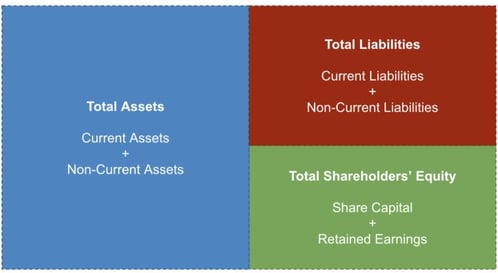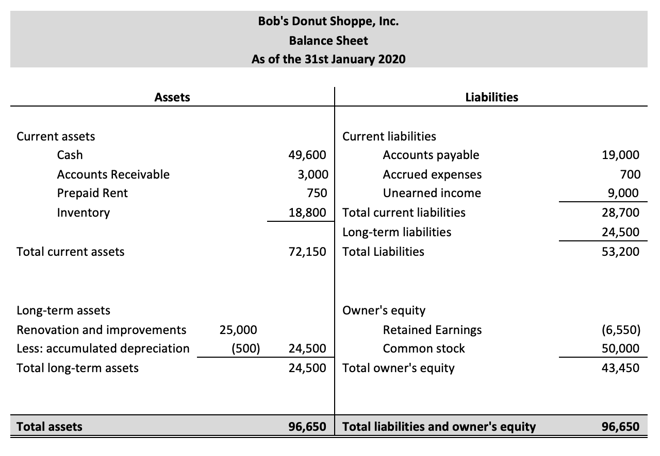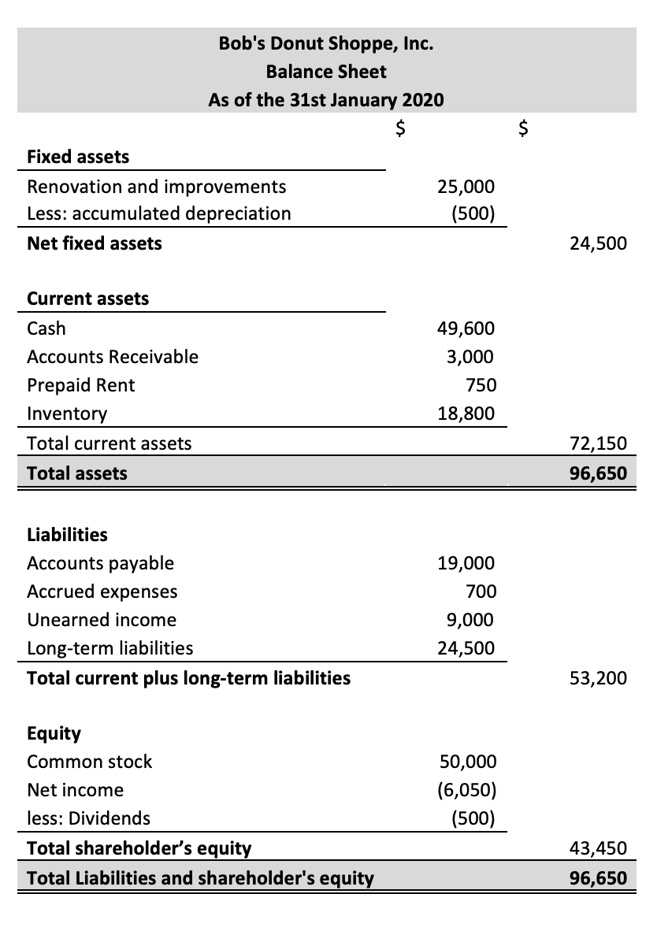The balance sheet is one of the general-purpose financial statements prepared during the accounting cycle. It displays the assets of a company and their sources of financing, debt and equity. It is also commonly known as a statement of net worth or a statement of the financial position of a company.

As we can see above, the balance sheet can be divided into two parts. The left side of the balance sheet displays the assets of a company. These would include both the fixed assets that have a useful life of over one year and current assets that are either cash or can be converted into cash in a short period of time. The right side of the balance sheet displays the two sources of funds that a company has drawn upon – liabilities and shareholder’s equity.
On both sides of the balance, the main items are generally listed by how liquid they are. For example, on the asset side, more liquid accounts such as cash, accounts receivable and inventory are listed before the more illiquid accounts like plant, property and equipment (PP&E).
The balance sheet displays the financial position of a company at a given point. Whereas, the income statement reports the financial performance of a company over the course of a period, usually a year. Investors and creditors will use the balance sheet to determine how efficiently a company is using its resources and how efficiently is it being financed.
Balance Sheet Template
Throughout this series on financial statements, you can download the Excel template below for free to see how Bob’s Donut Shoppe uses the balance sheet (and others) to evaluate the performance of his business.
Click here to download the Financial Statements template
Format of a Balance Sheet
The balance sheet can be reported in either of the following formats:
Account Format
This format divides the balance sheet into two columns. The left side would include the assets of a company consisting of both current assets and fixed assets. The right side of the balance sheet displays the liabilities and equity of a company. Think of this as a debit and a credit type format as the debit accounts come on the left side and the credit accounts come on the right-hand side.
Report Format
This will have only one column and it is the more traditional way of presenting the balance sheet. In this format, the assets appear first, followed by liabilities and equity of a company.
In both formats, the assets and liabilities are bifurcated into current and long term. They will also be listed generally by how liquid they are.
Components of a Balance Sheet
There are primarily 3 main components of a balance sheet as listed below:
- Assets
- Liabilities
- Equity
Assets
The assets side of the balance sheet helps the investors or the creditors who are reviewing the financial statements to determine what resources have the company invested in and how efficient are they in utilizing them. It helps with financial analysis by studying ratios like the current ratio, which shows whether the short-term assets are enough to cover the short-term obligations.
The assets can be subdivided into three sub-categories:
- Current assets: These are cash or cash equivalents that are expected to be converted to cash within a year. These include cash, accounts receivable, inventory, prepaid expenses and dues from affiliates.
- Non-current assets: These are the long-term assets of a company and represent a longer-term investment as they cannot be converted to cash quickly. They are usually held by a company for more than one year. Examples include equipment, land, property, investments in other companies, long-term notes receivables, etc.
- Intangible assets: These include those types of assets that lack a physical presence and substance, therefore making them very hard to be evaluated. Examples of some common types of intangible assets include patents, copyrights, goodwill, franchises, trademarks, trade names, mineral rights, etc.
Liabilities
These are defined as the financial debt and obligations that a company undertakes during the course of its business operations. These can be subdivided into the following categories:
- Current liabilities: These are amounts that are due and need to be paid with one year. Examples include accounts payable, accrued expenses, current portion of longer-term debt, unearned revenue, etc.
- Non-current liabilities: These are usually the longer-term obligations of a company that are expected to be paid after one year. These include notes payable, loan payable, mortgage payable, long-term lease obligations, deferred revenue, etc.
- Owner’s debt: A lot of times, a situation might arise where long term credit facilities are required by the company but are no longer available as banks might not be lending at attractive rates. Therefore, the company can borrow money from the owners at agreed-upon interest rates.
Equity

This simple equation does a lot in demonstrating that shareholder’s equity is the residual value of assets minus liabilities. Alternatively, equity can also be directly calculated as the combination of contributed capital (commons stock + preferred stock – treasury stock) and retained earnings (net income + other comprehensive income – dividends paid).
Balance Sheet Analysis
The balance sheet can be used by the investor, creditors or any other stakeholders in any of the following ways:
- It reveals the financial position of a business at a specific point in time. When previous periods are grouped and compared together, various trends and insights can be generated that could be used for forecasting purposes.
- A balance sheet can reveal how leveraged a company really is. If the total amount of debt exceeds the equity, we can say that the company is now operating at dangerously high levels of borrowing. Financial leverage can exponentially amplify the losses for a company in hard and difficult economic times.
- Investors might want to know how much cash the company has and whether it is sufficient for the company to pay them dividends.
- Various financial ratio analysis can be undertaken to identify problems a company might be facing. For example, an investor might calculate the inventory turnover, which might indicate that there is a lot of excess inventory. Another useful ratio is the fixed asset turnover, which determines how efficiently is a company utilizing its fixed assets.
Balance Sheet Example
Continuing with Bob and his donut shop example, we can see how his balance sheet would look at the end of his financial period, i.e. month-end.
The balance sheet in the two different formats are shown below:
Account Format

Report Format

FAQs
1. What is a balance sheet?
A balance sheet records a company's assets, liabilities, and net worth at a point in time.2. What is a balance sheet used for?
A balance sheet, or a statement of financial position, is a summary of all your business’ assets and liabilities. At any given point in time, it shows you how much money you would have left over if you sold all your assets and paid off all your debts.3. What are the key elements of balance sheet?
The balance sheet presents three important elements: assets, liabilities, and owner’s equity.
4. What are the 4 sections of a balance sheet?
The balance sheet is divided into four sections: heading, assets, liabilities, and owner's equity..
5. How do you analyze a balance sheet?
A balance sheet shows a company's assets, liabilities, and net worth. Assets include cash, inventory, and property. Liabilities include accounts payable and loans payable.
